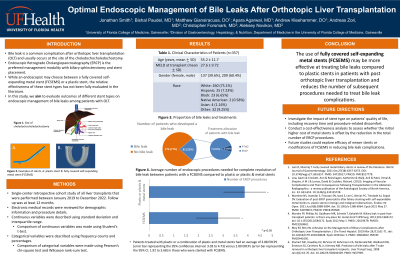Sunday Poster Session
Category: Biliary/Pancreas
P0047 - Optimal Endoscopic Management of Bile Leaks After Orthotopic Liver Transplantation
Sunday, October 27, 2024
3:30 PM - 7:00 PM ET
Location: Exhibit Hall E

Has Audio
.jpg)
Jonathan Smith
University of Florida College of Medicine
Gainesville, FL
Presenting Author(s)
Jonathan Smith, 1, Bishal Paudel, MD2, Matthew Giansiracusa, DO1, Apara Agarwal, MD2, Andrew Kleehammer, DO1, Andreas Zori, MD2, Christopher Forsmark, MD2, Aleksey Novikov, MD1
1University of Florida College of Medicine, Gainesville, FL; 2University of Florida, Gainesville, FL
Introduction: Bile leak is a common complication after orthotopic liver transplantation (OLT) and usually occurs at the choledochocholedochostomy. Endoscopic Retrograde Cholangiopancreatography (ERCP) is the preferred management modality, with biliary sphincterotomy and stent placement. While an endoscopist may choose between a fully covered self-expanding metal stent (FCSEMS) or a plastic stent, the relative effectiveness of these stent types has not been fully evaluated in the literature. In this study, we sought to evaluate outcomes of different stent types on endoscopic management of bile leaks among patients with OLT.
Methods: We conducted a retrospective study of all liver transplants that were performed between January 2019 to December 2022. Follow up was at least 12 months Electronic medical records were reviewed for demographic information and procedure details. Continuous variables were described using standard deviation and interquartile range, categorical variables were described using frequency counts and percentages. Comparison of continuous variables was made using Student’s t test and comparison of categorical variables were made using Pearson's chi-square test and Wilcoxon rank-sum test.
Results: We conducted a retrospective study of all liver transplants that were performed in our institution between January 2019 to December 2022. We identified 357 patients, including 81 who developed bile leaks (23%). Eight patients with a bile leak underwent percutaneous transhepatic biliary drainage (PTHD), and 73 patients underwent ERCP. The choice to perform PTHD was largely related to surgical anatomy. Patients treated with metal stents needed significantly fewer total endoscopic procedures. Patients treated with FCSEMS had an average of 2.80 ERCPs (95% CI: 1.92 to 3.68) versus 3.88 ERCPs (95% CI: 3.03 to 4.73) needed in those who were stented with plastic or a combination of plastic and metal stents (p< 0.05).
Discussion: These data support the observation that the use of FCSEMS in patients with post-OLT bile leaks may help to reduce the number of procedures needed to treat this problem.
Note: The table for this abstract can be viewed in the ePoster Gallery section of the ACG 2024 ePoster Site or in The American Journal of Gastroenterology's abstract supplement issue, both of which will be available starting October 27, 2024.
Disclosures:
Jonathan Smith, 1, Bishal Paudel, MD2, Matthew Giansiracusa, DO1, Apara Agarwal, MD2, Andrew Kleehammer, DO1, Andreas Zori, MD2, Christopher Forsmark, MD2, Aleksey Novikov, MD1. P0047 - Optimal Endoscopic Management of Bile Leaks After Orthotopic Liver Transplantation, ACG 2024 Annual Scientific Meeting Abstracts. Philadelphia, PA: American College of Gastroenterology.
1University of Florida College of Medicine, Gainesville, FL; 2University of Florida, Gainesville, FL
Introduction: Bile leak is a common complication after orthotopic liver transplantation (OLT) and usually occurs at the choledochocholedochostomy. Endoscopic Retrograde Cholangiopancreatography (ERCP) is the preferred management modality, with biliary sphincterotomy and stent placement. While an endoscopist may choose between a fully covered self-expanding metal stent (FCSEMS) or a plastic stent, the relative effectiveness of these stent types has not been fully evaluated in the literature. In this study, we sought to evaluate outcomes of different stent types on endoscopic management of bile leaks among patients with OLT.
Methods: We conducted a retrospective study of all liver transplants that were performed between January 2019 to December 2022. Follow up was at least 12 months Electronic medical records were reviewed for demographic information and procedure details. Continuous variables were described using standard deviation and interquartile range, categorical variables were described using frequency counts and percentages. Comparison of continuous variables was made using Student’s t test and comparison of categorical variables were made using Pearson's chi-square test and Wilcoxon rank-sum test.
Results: We conducted a retrospective study of all liver transplants that were performed in our institution between January 2019 to December 2022. We identified 357 patients, including 81 who developed bile leaks (23%). Eight patients with a bile leak underwent percutaneous transhepatic biliary drainage (PTHD), and 73 patients underwent ERCP. The choice to perform PTHD was largely related to surgical anatomy. Patients treated with metal stents needed significantly fewer total endoscopic procedures. Patients treated with FCSEMS had an average of 2.80 ERCPs (95% CI: 1.92 to 3.68) versus 3.88 ERCPs (95% CI: 3.03 to 4.73) needed in those who were stented with plastic or a combination of plastic and metal stents (p< 0.05).
Discussion: These data support the observation that the use of FCSEMS in patients with post-OLT bile leaks may help to reduce the number of procedures needed to treat this problem.
Note: The table for this abstract can be viewed in the ePoster Gallery section of the ACG 2024 ePoster Site or in The American Journal of Gastroenterology's abstract supplement issue, both of which will be available starting October 27, 2024.
Disclosures:
Jonathan Smith indicated no relevant financial relationships.
Bishal Paudel indicated no relevant financial relationships.
Matthew Giansiracusa indicated no relevant financial relationships.
Apara Agarwal indicated no relevant financial relationships.
Andrew Kleehammer indicated no relevant financial relationships.
Andreas Zori indicated no relevant financial relationships.
Christopher Forsmark indicated no relevant financial relationships.
Aleksey Novikov indicated no relevant financial relationships.
Jonathan Smith, 1, Bishal Paudel, MD2, Matthew Giansiracusa, DO1, Apara Agarwal, MD2, Andrew Kleehammer, DO1, Andreas Zori, MD2, Christopher Forsmark, MD2, Aleksey Novikov, MD1. P0047 - Optimal Endoscopic Management of Bile Leaks After Orthotopic Liver Transplantation, ACG 2024 Annual Scientific Meeting Abstracts. Philadelphia, PA: American College of Gastroenterology.

